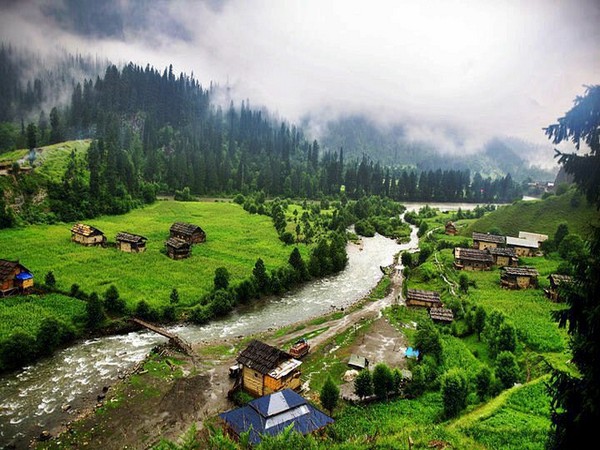J&K transformed after scrapping Article 370, infrastructure development in remote villages
Srinagar (Jammu and Kashmir) [India], July 31 (ANI): Jammu and Kashmir is set to celebrate the fourth anniversary of the abrogation of Article 370 on August 5, 2023. The Jammu and Kashmir administration can proudly claim that it has achieved extraordinary success in its effort to build better roads in the Union Territory.

Within the last four years, there has been a revolutionary change in the construction of roads, bridges in Jammu and Kashmir.
Roads under construction in villages for years, which were abandoned after earth cutting or were tried to be made passable by laying mud and barge, but in these four years, standard blacktopping was done.
More or less all the districts of J-K now have a number of such villages on roads, with good road connectivity, standard black topping and these roads passing between the villages present a very attractive sight.
Under the Prime Minister’s Development Package (PMDP), 53 projects worth Rs 58,477 crore are being implemented in Jammu and Kashmir in various sectors like roads, power, health, education, tourism, agriculture, skill development.
After the abrogation of Article 370 in Jammu and Kashmir on August 5, 2019, the speed of road construction has increased from 6.54 km to 20.6 km per day. The total length of roads in Jammu and Kashmir has now reached 46,141 km. The increasing pace of black topping of roads and increasing road length indicate how fast Jammu and Kashmir has progressed during the last four years.
According to the data, the length of the roads in Jammu and Kashmir has increased almost 46,141 km and the percentage of black-top roads has reached 78 per cent as against 66 per cent in 2019.
Under the pothole-free road program, a target of 5,900 km was set for 2021-22, of which 4,900 have been completed so far. Union-administered Jammu and Kashmir has once again been ranked among the top three nationally for road length constructed annually under the Pradhan Mantri Gram Sadak Yojana (PMGSY) and was included as PWD constructed 3,284 km of PMGSY road length in 2021-22.
114 townships connected through road network by implementing 427 schemes in one year. J-K has continued to improve its performance for road length construction every year since 2019 as it ranked 2019-20. It moved from 12th to 9th and then to 3rd position in consecutive years -21 2020 and -22 2021.
As per 2011 census all settlements with population above 1000 are provided road connectivity. Work is also underway to provide road connectivity to settlements with a population of 500 by 2022-23.
The Public Works Department has seen massive reforms over the past four years, including the implementation of the Jammu and Kashmir Public Works Engineering Manual 2021, the formulation of Road Maintenance Policy 2021-22 (Implementation and Quality Control) and the DLP Enforcement Manual, regular departmental operations.
For SOP, introduction of online management monitoring accounting system, introduction of two party quality control mechanism, development and introduction of our road mobile apps etc.
32 complaints were redressed on Central Government’s Public Grievance Redressal and Monitoring System, an online platform available 24×7 for citizens to register their grievances.
For 70 years, proper road in Jammu and Kashmir was not there and was no connectivity. It is unfortunate but true that Jammu and Kashmir was without proper road connectivity for 70 years.
It takes 12 to 14 hours to cover a distance of 300 km from Srinagar to Jammu and in contrast the Srinagar-Jammu National Highway has been upgraded in the last four years and now it takes only 6 to 7 hours to travel between the two capitals.
It seemed that many development projects that were dead or incomplete have become reality and many more are likely to be launched in the next few years.
Communication is key and the system under the leadership of Prime Minister Narendra Modi has no qualms in ensuring this.
Leaving the problem of connectivity of Jammu and Kashmir with the rest of the country to be solved forever. During the last three years, Jammu and Kashmir has become like the rest of the country.
The people of the Himalayan region are getting what they deserve. They were kept out of the country under the illusion of “special status” by their so-called “Messiah”, who ruled the erstwhile state for 70 years but failed to deliver. From 1947 to 2019, politicians chanted and kept people engaged by making announcements. Proper road connectivity is the lifeline of any region and after 5th August 2019, Jammu and Kashmir is moving towards the best possible connectivity.
Meanwhile, things are moving at a fast pace and no one is allowed to be complacent. The results and change are visible and the figures are speaking.
Connecting Inaccessible Slums: The government has launched a mission to connect the slums which have been inaccessible since 1947.
The road network is being expanded, especially in rural and remote areas. Many targets have been achieved under various schemes implemented for construction, improvement and upgradation of roads and bridges.
Pradhan Mantri Gram Sadak Yojana (PMGSY), Bridge Programme, Central Road and Infrastructure Fund (CRIF), NABARD, schemes like road sector, cities and towns (Macedimisation), long-wishing projects and pothole-free road schemes etc are being implemented to the letter.
As of August 2019, the concept of providing good governance was absent in Jammu and Kashmir. The situation changed after the conversion of Jammu and Kashmir into a Union Territory. The leaders focused their attention on the problems faced by the common man and tried to find solutions to them.
As Jammu and Kashmir celebrates the third anniversary of the abrogation of Article 370, the Jammu and Kashmir administration proudly claims this. Can say that it has achieved extraordinary success in its efforts to build better roads in the Union Territory.





